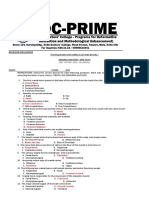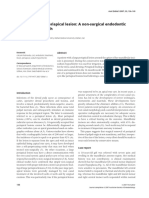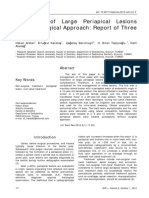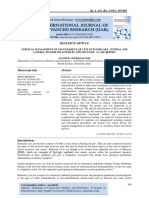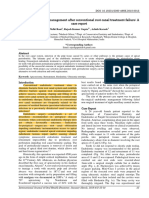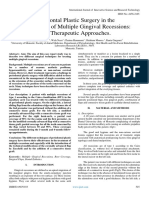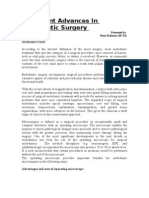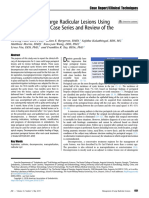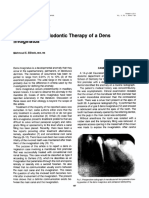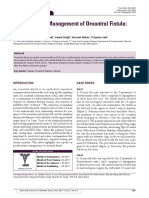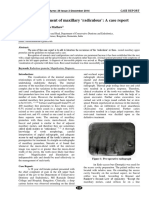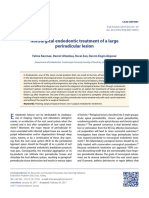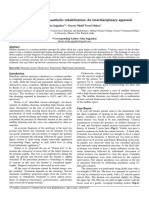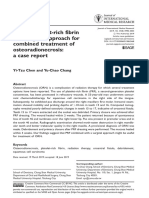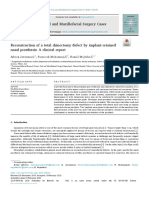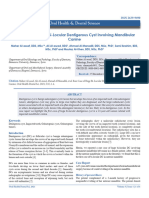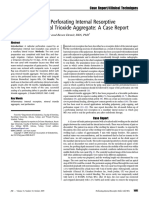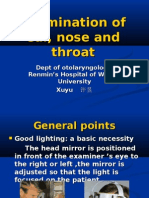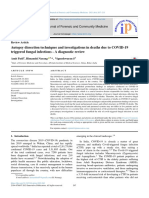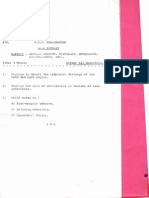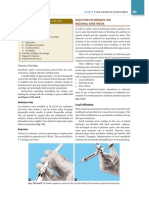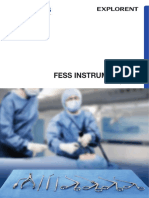Endodontic Treatment of A Large Periradicular Lesion: A Case Report
Endodontic Treatment of A Large Periradicular Lesion: A Case Report
Uploaded by
Sholehudin Al AyubiCopyright:
Available Formats
Endodontic Treatment of A Large Periradicular Lesion: A Case Report
Endodontic Treatment of A Large Periradicular Lesion: A Case Report
Uploaded by
Sholehudin Al AyubiOriginal Description:
Original Title
Copyright
Available Formats
Share this document
Did you find this document useful?
Is this content inappropriate?
Copyright:
Available Formats
Endodontic Treatment of A Large Periradicular Lesion: A Case Report
Endodontic Treatment of A Large Periradicular Lesion: A Case Report
Uploaded by
Sholehudin Al AyubiCopyright:
Available Formats
See discussions, stats, and author profiles for this publication at: https://www.researchgate.
net/publication/257251145
Endodontic Treatment of a Large Periradicular Lesion: A Case Report
Article in Iranian Endodontic Journal · October 2008
Source: PubMed
CITATIONS READS
3 1,667
2 authors:
Saeed Asgary Sara Ehsani
Shahid Beheshti University of Medical Sciences Tehran University of Medical Sciences
192 PUBLICATIONS 4,809 CITATIONS 18 PUBLICATIONS 335 CITATIONS
SEE PROFILE SEE PROFILE
Some of the authors of this publication are also working on these related projects:
Push-out Bond Strength of Fiber Posts to Intraradicular Dentin Using Multimode Adhesive System View project
Evaluation of four pulpotomy techniques in primary molars View project
All content following this page was uploaded by Saeed Asgary on 21 May 2014.
The user has requested enhancement of the downloaded file.
CASE REPORT
Endodontic treatment of a large periradicular
lesion: A case report
1* 2
Saeed Asgary DDS, MS and Sara Ehsani DDS, MS
1. Professor of Endodontics, Iranian center for endodontic research, Dental Research Center, Dental school, Shahid Beheshti
University MC, Evin, Tehran, Iran.
2. Oral Radiologist, Dental Research Center, Shahid Beheshti University MC, Tehran, Iran.
Abstract
This case report describes the endodontic treatment of a large cyst-like periradicular lesion a 29-
year-old female with a large chronic periapical abscess in the region of right maxillary sinus
presented into private practice, accompanied with non-vital first upper molar and poorly root
treated second upper molar. Conservative root canal treatment was carried out for both of the
involved teeth in a single appointment. Post operative examination after two weeks revealed
complete resolution of the sinus tract. The clinical and radiographic examination after 9 months
revealed complete periapical healing. The appropriate diagnosis of periradicular lesion and the
treatment of the infected root canal system allowed complete healing of these large lesions
without endodontic surgery.
Keywords: Healing, Maxillary sinus, Office visits, Radicular cyst, Root canal therapy.
Received March 2008; accepted August 2008
*Correspondence: Dr. Saeed Asgary; Iranian center for endodontic research, Dental school, Shahid
Beheshti University MC, Tehran, Iran. E-mail: saasgary@yahoo.com
Introduction (4). The following case report describes an
Pulpal tissue can become infected through orthograde endodontic treatment of first and
various ways such as caries or trauma, making second maxillary molars associated with a large
the pulpal tissue necrotic. The microbial cyst-like periradicular lesion.
aggregation or its by-products can infiltrate into
periradicular tissues and stimulate the host Case Report
defense system, resulting in periapical/ A 29-year-old female attended a private
periradicular tissue destruction. Although this endodontic clinic; her chief complaint was the
defensive lesion may be helpful to prevent presence of mild pain in right maxillary sinus
further progress of the microbial infection, it is area. The patient had no significant medical
not self-healing and results in various types of history. Right maxillary first molar was not
lesions (1). The general consensus is that previously root treated, was not carious and had
bacterial reduction or elimination from the root no history of trauma. The adjacent second
canal system by effective biomechanical molar had poor endodontic root treatment with
preparation will lead to more successful an incomplete obturation (Figure 1-A).
outcomes (2). Investigators have shown that Extra oral examination revealed no sign or
large periradicular lesion may respond symptom. Intraoral examination revealed a
positively to nonsurgical endodontic treatment minor firm swelling of the vestibule above the
(3-5). In cases were response to conservative molars and an associated sinus tract on the
treatment is not successful other treatment buccal alveolar process. Palpation produced
modalities can be considered. Non-surgical purulent exudates and the mucosa in the region
retreatment is usually the treatment of choice was inflamed. Teeth were not tender to
though occasionally periradicular surgery may percussion and were not mobile. Electric pulp
be the treatment of choice, or even extraction test and cavity test exhibited negative results
may be necessary to allow the lesion to heal for right maxillary first molar.
134 IEJ -Volume 3, Number 4, Fall 2008
Large endodontic lesion
Figure 1. Panoramic radiography
demonstrating:
A) First and second right
maxillary molars probably
responsible for the cyst-like lesion
appearing at their apices,
B) Gutta-percha used for tracing
the course of sinus tract showing
occluso-apical dimension of the
lesion which was not detected in
periapical view, and
C) Complete healing of the lesion 9
months after root canal therapy
and permanent restoration
Gutta-percha was used to trace the path of sinus had disappeared after two weeks of treatment.
tract by periapical radiographic technique; On 9 month and one year recalls, the patient
however as the entire course of the sinus tract had no sign and symptom; panoramic and
was not apparent, panoramic radiograph was periapical radiographic evaluation demonstrate-
taken (Figure 1-B). The panoramic tomograoh ed complete bony regression of the lesion
revealed a well-circumscribed radiolucency (Figure 1-C and 4). Clinical exam revealed no
measuring approximately 25 mm in diameter, sensitivity to percussion and palpation.
extending from distal aspect of the second
premolar to distal aspect of the second Discussion
maxillary molar. Right maxillary first molar This case illustrated a cyst-like periradicular
also showed a profound root resorption. lesion, most probably a radicular cyst. The
Adjacent teeth had no root resorption. exact diagnosis can be made by microscopic
The patient´s clinical and radiographic findings examination. However, the clinical diagnosis of
seemed to suggest a large cyst-like peri- a radicular cyst seemed rational because the
radicular lesion, most likely to be an infected lesion accompanied nonvital teeth, was more
radicular cyst of endodontic origin. than 1.6 mm in diameter, and was bordered
One visit endodontic treatment was performed with a radiopaque line resembling cystic
for the right maxillary first and second molars, lesions (6,7).
in one session. After access cavity preparation, As mentioned in previous studies, in the cases
treatment was continued with a rubber dam in of periradicular radiolucent lesions, sufficient
place. There were no exudates from the canals. biomechanical cleaning of the root canal
Instrumentation was performed by Flexo-File system is the most critical factor for healing. It
(Dentsply, Maillefer, Switzerland) #15-40, has been demonstrated that in these cases, non-
using step-back technique, accompanying with surgical root canal therapy should be the first
copious irrigation with sterile normal saline line of treatment (2) and approximately 74% of
between instruments. The working length was 42 endodontically treated teeth in one study
determined on the basis of radiographs. showed bony healing within their large
Obturation was performed with gutta-percha periradicular lesions (5). While some studies
(Ariadent, Tehran, Iran) and sealer (Roth's 801 have shown no difference between large and
sealer, Roth International, Chicago, IL, USA) small lesions’ healing ability (8), according to
by lateral condensation technique (Figure 3). Calişkan the prognosis for large periradicular
After two weeks of treatment, teeth were lesions is lower (5).
permanently restored with amalgam (Synalloy, Permanent restoration within two weeks of
Dentoria, France). The patient was recalled RCT also contributed to periradicular healing,
after one day, two weeks, 9 and 12 months. The as several studies have shown that an adequate
signs and symptoms, including the sinus tract, coronal restoration-placed as soon as possible
IEJ -Volume 3, Number 4, Fall 2008 135
Asgary & Ehsani
Figure 2. Periapical view Figure 3. Periapical radio- Figure 4. Periapical radio-
showing a part of customized graph after root canal filling graph demonstrating healing
gutta-percha for tracing and permanent restoration on the 12-months recall visit
after RCT-plays an important role in the origin without surgical treatment. Aust Endod J
outcome of endodontic therapy (9-11). 2007;33:36-41.
3. Ozan U, Er K. Endodontic treatment of a large
This patient was a young healthy subject and
cyst-like periradicular lesion using a combination of
these factors will contribute to successful antibiotic drugs: a case report. J Endod 2005;31:898-
radiographical and clinical healing; previous 900.
studies have showed that the patient’s general 4. Oztan MD. Endodontic treatment of teeth
health may have an influence on the healing associated with a large periapical lesion. Int Endod J
process in periradicular lesions (2). Although 2002;35:73-8.
the number of appointments (one-visit versus 5. Calişkan MK. Prognosis of large cyst-like
periapical lesions following nonsurgical root canal
two-visit) for root canal therapy was one of the treatment: a clinical review. Int Endod J 2004;37:408-
most controversial issues in endodontics for 16.
years, a Cochrane systematic review in 2008 6. White SC, Pharaoh MJ. Oral radiology. 5th
revealed that there is no significant difference Edition. St Louis: CV Mosby; 2004. P. 385.
between single and multiple visits in the 7. Wood NK, Goaz PW, Jacobs MC. Periapical
radiologic success of RCT (12). This case was radiolucencies. In: Wood NK, Goaz PW. Differential
diagnosis of oral and maxillofacial lesions. 5th Edition.
treated in one visit, confirming that one-visit
St Louis: CV Mosby; 1996. P. 257.
RCT can have successful results (13). 8. Sjogren U, Hagglund B, Sundqvist G, Wing K.
Radiographic changes such as the increase in Factors affecting the long-term results of endodontic
density of the lesion and trabecular treatment. J Endod 1990;16:498-504.
regeneration, confirmed healing in addition to 9. Kayahan MB, Malkondu O, Canpolat C, Kaptan
the absence of signs and symptoms. However it F, Bayirli G, Kazazoglu E. Periapical health related to
is difficult to be sure of complete healing with the type of coronal restorations and quality of root
canal fillings in a Turkish subpopulation. Oral Surg
conventional radiographic techniques. Oral Med Oral Pathol Oral Radiol Endod
2008;105:e58-62.
Conclusion 10. Siqueira JF Jr, Rôças IN, Alves FR, Campos LC.
In the present case, single visit root canal Periradicular status related to the quality of coronal
therapy without any intracanal medicament, restorations and root canal fillings in a Brazilian
proved successful in promoting healing of a population. Oral Surg Oral Med Oral Pathol Oral
Radiol Endod 2005;100:369-74.
large cyst-like periradicular lesion. The result 11. Heling I, Gorfil C, Slutzky H, Kopolovic K,
confirms previous reports demonstrating that Zalkind M, Slutzky-Goldberg I. Endodontic failure
even large periradicular lesions can respond caused by inadequate restorative procedures: review
successfully to non-surgical single-visit and treatment recommendations. J Prosthet Dent
endodontic treatment. 2002;87:674-8.
12. Figini L, Lodi G, Gorni F, Gagliani M. Single
References versus multiple visits for endodontic treatment of
1. Nair PNR. Pathobiology of primary apical permanent teeth: a Cochrane systematic review. J
periodontitis. In: Cohen S, Hargreaves KM. Pathway Endod 2008;34:1041-7.
of the pulp, 9th Ed. St.Lous: CV Mosby; 2006. P541-2. 13. Eleazer PD, Eleazer KR. Flare-up rate in pulpally
2. Broon NJ, Bortoluzzi EA, Bramante CM. Repair necrotic molars in one-visit versus two-visit
of large periapical radiolucent lesions of endodontic endodontic treatment. J Endod 1998;24:614-6.
136 IEJ -Volume 3, Number 4, Fall 2008
View publication stats
You might also like
- Daniel Castro IndictmentDocument27 pagesDaniel Castro IndictmentWWMTNo ratings yet
- 2019 2020 Reviewer Cluster CompilationDocument130 pages2019 2020 Reviewer Cluster CompilationPatricia L.No ratings yet
- Endodontic Treatment of A Large Periradicular Lesion: A Case ReportDocument4 pagesEndodontic Treatment of A Large Periradicular Lesion: A Case ReportSholehudin Al AyubiNo ratings yet
- Case Report19Document6 pagesCase Report19irfanaNo ratings yet
- Healing of Large Periapical Lesion A Non-Surgical EndodonticDocument5 pagesHealing of Large Periapical Lesion A Non-Surgical EndodonticmeryemeNo ratings yet
- 71-Manuscript File-160-1-10-20170719Document6 pages71-Manuscript File-160-1-10-20170719sulistiyaNo ratings yet
- EndoDocument3 pagesEndoJessicaLisaNugrohoNo ratings yet
- Apiko 1Document5 pagesApiko 1Asri DamayantiNo ratings yet
- PeriapikalDocument7 pagesPeriapikalHanindyaNoorAgusthaNo ratings yet
- Surgical Management of Giant Radicular Cyst of Maxillary Central and Lateral Incisor Followed by Apicoectomy - A Case ReportDocument10 pagesSurgical Management of Giant Radicular Cyst of Maxillary Central and Lateral Incisor Followed by Apicoectomy - A Case ReportIJAR JOURNALNo ratings yet
- 16990-Article Text-33353-1-10-20210901Document5 pages16990-Article Text-33353-1-10-20210901sharing sessionNo ratings yet
- Retrograde PreparationDocument16 pagesRetrograde Preparationwhussien7376100% (1)
- Apiko 5Document3 pagesApiko 5Asri DamayantiNo ratings yet
- A Central Incisor With 4 Independent Root Canals: A Case ReportDocument4 pagesA Central Incisor With 4 Independent Root Canals: A Case ReportJing XueNo ratings yet
- Progression of Periapical Cystic Lesion AfterDocument6 pagesProgression of Periapical Cystic Lesion Afterdr.angelbautistaNo ratings yet
- Mermigos 11 01Document4 pagesMermigos 11 01Sankurnia HariwijayadiNo ratings yet
- Borkar 2015Document6 pagesBorkar 2015Jing XueNo ratings yet
- Endodontic Treatment of Mandibular Premolars With Complex Anatomy Case SeriesDocument5 pagesEndodontic Treatment of Mandibular Premolars With Complex Anatomy Case SeriesInternational Journal of Innovative Science and Research TechnologyNo ratings yet
- Management of Infected Radicular Cyst by Surgical Approach: Case ReportDocument2 pagesManagement of Infected Radicular Cyst by Surgical Approach: Case ReportEzza RiezaNo ratings yet
- Case Report A Rare Case of Single-Rooted Mandibular Second Molar With Single CanalDocument6 pagesCase Report A Rare Case of Single-Rooted Mandibular Second Molar With Single CanalKarissa NavitaNo ratings yet
- Enhancing Fracture Resistance in Coronal Structure of Endodontically Treated Teeth by Placing Horizontal Posts in Buccolingual Direction: Case ReportDocument5 pagesEnhancing Fracture Resistance in Coronal Structure of Endodontically Treated Teeth by Placing Horizontal Posts in Buccolingual Direction: Case ReportInternational Journal of Innovative Science and Research TechnologyNo ratings yet
- Periodontal Plastic Surgery in The Management of Multiple Gingival Recessions Two Therapeutic ApproachesDocument5 pagesPeriodontal Plastic Surgery in The Management of Multiple Gingival Recessions Two Therapeutic ApproachesInternational Journal of Innovative Science and Research TechnologyNo ratings yet
- Dens Evaginatus and Type V Canal Configuration: A Case ReportDocument4 pagesDens Evaginatus and Type V Canal Configuration: A Case ReportAmee PatelNo ratings yet
- Recent Advances in Endodontic SurgeryDocument29 pagesRecent Advances in Endodontic Surgeryhenavns50% (2)
- Tanpa Judul PDFDocument7 pagesTanpa Judul PDFnadyashintakasihNo ratings yet
- Go Piis0099239918308744Document9 pagesGo Piis0099239918308744CARLA PATRICIA JORDAN SALAZARNo ratings yet
- Maxillary Labial Frenectomy by Using ConDocument6 pagesMaxillary Labial Frenectomy by Using ConShinta rahma MansyurNo ratings yet
- Radicular Cyst Management Due To Endodontic Failure - A Case StudyDocument4 pagesRadicular Cyst Management Due To Endodontic Failure - A Case StudyBOHR International Journal of Current research in Dentistry (BIJCRID)No ratings yet
- Endo PDFDocument91 pagesEndo PDFPolo RalfNo ratings yet
- Calcium Hydroxide Induced Healing of Periapical RaDocument4 pagesCalcium Hydroxide Induced Healing of Periapical RaMaría José VanegasNo ratings yet
- EndoDocument5 pagesEndohelmuthw0207No ratings yet
- Management of Large Radicular Lesions Using DecompressionDocument9 pagesManagement of Large Radicular Lesions Using Decompressionsoho1303No ratings yet
- Management of Infected Radicular Cyst by Marsupialization: Case ReportDocument5 pagesManagement of Infected Radicular Cyst by Marsupialization: Case Reportvivi hutabaratNo ratings yet
- 107 Nonsurgical Endodontic Therapy of A Dens InvaginatusDocument3 pages107 Nonsurgical Endodontic Therapy of A Dens InvaginatusAurelian DentistNo ratings yet
- Css Prostho Jurnal SyarifDocument3 pagesCss Prostho Jurnal SyarifRein KarnasiNo ratings yet
- 2019 Hahn LeeDocument4 pages2019 Hahn LeeR KNo ratings yet
- Dentistry CaseDocument3 pagesDentistry CaseA ANo ratings yet
- 2022 AiutoDocument7 pages2022 AiutovivianaNo ratings yet
- Arnold2013 PDFDocument6 pagesArnold2013 PDFJing XueNo ratings yet
- The Importance of Recognizing Pathology Associated With Retained Third MolarsDocument5 pagesThe Importance of Recognizing Pathology Associated With Retained Third MolarsKarim El MestekawyNo ratings yet
- Surgical and Endodontic Management of Large Cystic Lesion: AbstractDocument5 pagesSurgical and Endodontic Management of Large Cystic Lesion: AbstractanamaghfirohNo ratings yet
- Management of C Shaped Canals: A Case Series: IOSR Journal of Dental and Medical Sciences March 2021Document7 pagesManagement of C Shaped Canals: A Case Series: IOSR Journal of Dental and Medical Sciences March 2021Prathiksha ShettyNo ratings yet
- Dental Medical JournalDocument4 pagesDental Medical JournalIntan PermatasariNo ratings yet
- Cogajo Nasoseptal PediculadoDocument7 pagesCogajo Nasoseptal PediculadoRafa LopezNo ratings yet
- Emergency Endodontics 6Document3 pagesEmergency Endodontics 6098 - SILVYARA AYU PRATIWINo ratings yet
- Apicoectomy - A ReviewDocument5 pagesApicoectomy - A ReviewnishthaNo ratings yet
- Closure of Midline Diastema by Multidisciplinary Approach - A Case ReportDocument5 pagesClosure of Midline Diastema by Multidisciplinary Approach - A Case ReportAnonymous izrFWiQNo ratings yet
- Role of PeriodontistDocument5 pagesRole of PeriodontistNeetha ShenoyNo ratings yet
- Diastemma ClosureDocument3 pagesDiastemma Closureisha sajjanharNo ratings yet
- 2019 - Use of Platelet Rich Fibrin and Surgical Approach For Combined Treatment of RadionecrosisDocument6 pages2019 - Use of Platelet Rich Fibrin and Surgical Approach For Combined Treatment of RadionecrosisSyifa IKNo ratings yet
- Ricucci 2014Document7 pagesRicucci 2014leiliromualdoNo ratings yet
- Article 1603861587Document7 pagesArticle 1603861587Nathania AstriaNo ratings yet
- Articol PMFDocument6 pagesArticol PMFclaudia lupuNo ratings yet
- Recovery of Pulp Sensibility After The Surgical Management of A Large Radicular CystDocument5 pagesRecovery of Pulp Sensibility After The Surgical Management of A Large Radicular CystmeryemeNo ratings yet
- Residual CystDocument4 pagesResidual Cyst053 Sava Al RiskyNo ratings yet
- Maxillary Arch Distalization Using Interradicular Miniscrews and The Lever-Arm ApplianceDocument8 pagesMaxillary Arch Distalization Using Interradicular Miniscrews and The Lever-Arm ApplianceJuan Carlos CárcamoNo ratings yet
- Rapid Maxillary Expansion Appliance in Correction of Unilateral Skeletal Crossbite in An Adult Female Patient: A Case ReviewDocument5 pagesRapid Maxillary Expansion Appliance in Correction of Unilateral Skeletal Crossbite in An Adult Female Patient: A Case Reviewdrzana78No ratings yet
- Rare Case of Huge Bilocular Dentigerous Cyst Involving Mandibular CanineDocument4 pagesRare Case of Huge Bilocular Dentigerous Cyst Involving Mandibular CanineScivision PublishersNo ratings yet
- DE1 CR Baksh 2 5 36CDocument4 pagesDE1 CR Baksh 2 5 36CAyu SawitriNo ratings yet
- Management of A Perforating Internal Resorptive Defect With Mineral Trioxide Aggregate: A Case ReportDocument4 pagesManagement of A Perforating Internal Resorptive Defect With Mineral Trioxide Aggregate: A Case ReportJing XueNo ratings yet
- Management of Perforations of The NasalDocument5 pagesManagement of Perforations of The NasaljoseluisorlmeixoeiroNo ratings yet
- Peri-Implant Complications: A Clinical Guide to Diagnosis and TreatmentFrom EverandPeri-Implant Complications: A Clinical Guide to Diagnosis and TreatmentNo ratings yet
- Diagnostic Imaging and Image-Guided Interventions Sinus SurgeryDocument40 pagesDiagnostic Imaging and Image-Guided Interventions Sinus SurgeryIvan de GranoNo ratings yet
- MCQ Head & NeckDocument5 pagesMCQ Head & NeckSyafiqah Ahmad100% (3)
- Chapter 17 Maxillary SinusDocument15 pagesChapter 17 Maxillary SinusRini RahmawulandariNo ratings yet
- Chapter 3 - Anatomy, Physiology (Essentials of Dental Assisting)Document35 pagesChapter 3 - Anatomy, Physiology (Essentials of Dental Assisting)mussanteNo ratings yet
- Acute Sinusitis: Diagnosis, Management, and ComplicationsDocument27 pagesAcute Sinusitis: Diagnosis, Management, and Complications1720209111No ratings yet
- Examination of Ear - Nose and - ThroatDocument77 pagesExamination of Ear - Nose and - Throatapi-19641337100% (3)
- Q.P Code: 544222Document16 pagesQ.P Code: 544222وليد خالدNo ratings yet
- Chiapasco2012 PDFDocument7 pagesChiapasco2012 PDFJeffly Varro GilbertNo ratings yet
- Radiology in Pediatric DentistryDocument125 pagesRadiology in Pediatric DentistryHebah NawafNo ratings yet
- Chronic RhinosinusitisDocument8 pagesChronic RhinosinusitisYunardi Singgo100% (1)
- Diacnosis Dan: A SinonasalDocument29 pagesDiacnosis Dan: A SinonasalWiwiet ArwistaNo ratings yet
- Nasal CavityDocument4 pagesNasal Cavitykep1313No ratings yet
- Lateral Wall of NoseDocument11 pagesLateral Wall of NoseaparnajechuNo ratings yet
- Anatomic: Variants in Sinonasal CT1Document35 pagesAnatomic: Variants in Sinonasal CT1CHAKRADharNo ratings yet
- Autopsy Dissection Techniques and Investigations in Deaths Due To COVID-19Document7 pagesAutopsy Dissection Techniques and Investigations in Deaths Due To COVID-19himanshiNo ratings yet
- 11 Surgical Treatment of SinusitisDocument69 pages11 Surgical Treatment of SinusitissevattapillaiNo ratings yet
- Instant download Otolaryngology Head and Neck Surgery A Clinical Reference Guide Second Edition R. Pasha pdf all chapterDocument85 pagesInstant download Otolaryngology Head and Neck Surgery A Clinical Reference Guide Second Edition R. Pasha pdf all chaptertheodysyngho100% (3)
- Log Book in OMS Arab Board 2022-2Document21 pagesLog Book in OMS Arab Board 2022-2dr.m.m.yousifNo ratings yet
- NTRUHS MDS Oral Surgery Questions 1Document21 pagesNTRUHS MDS Oral Surgery Questions 1DrRevath Vyas80% (5)
- Injection Techniques For Regional Anesthesia: Contents of CartridgeDocument27 pagesInjection Techniques For Regional Anesthesia: Contents of CartridgeAisyah Arina NurhafizahNo ratings yet
- Comparison of Piezosurgery and Conventional RotatiDocument5 pagesComparison of Piezosurgery and Conventional RotatiMohammad HarrisNo ratings yet
- FESS Instrument Set Brochure W7053245Document4 pagesFESS Instrument Set Brochure W7053245devitrasandyNo ratings yet
- 5 - Oral Surgery & Pain ControlDocument170 pages5 - Oral Surgery & Pain ControlPriya Sargunan83% (6)
- Exam Questions Pediatric OMF Surgery V Eng 2021-2022 (Repaired)Document53 pagesExam Questions Pediatric OMF Surgery V Eng 2021-2022 (Repaired)Beni KelnerNo ratings yet
- Icd 9Document16 pagesIcd 9HaeriyahNo ratings yet
- 4537-046 - Ra - EU - Product CatalogDocument11 pages4537-046 - Ra - EU - Product CatalogFreire Jose FranciscoNo ratings yet
- Use of Buccal Advancement Flap For Repair of Oroantral Fistula A Case Series StudyDocument4 pagesUse of Buccal Advancement Flap For Repair of Oroantral Fistula A Case Series StudyAhmad AbrorNo ratings yet
- Chapter 04 Extraoral and Occlusal Anatomic LandmarksDocument22 pagesChapter 04 Extraoral and Occlusal Anatomic LandmarksFaith AnneessaNo ratings yet

